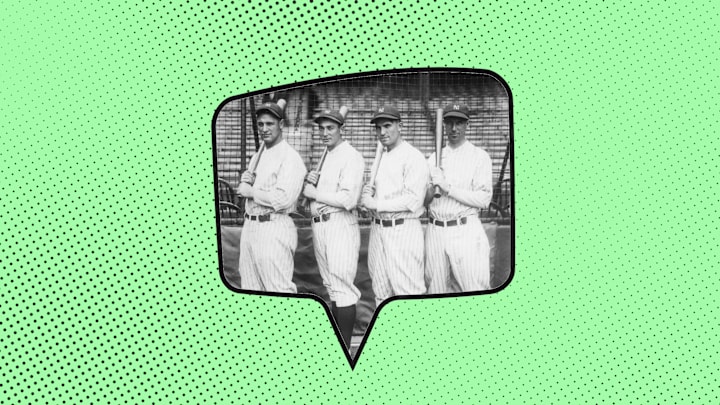The batting order for the 1927 New York Yankees featured such a formidable stack of all-stars that opposing pitchers could well be forgiven for shaking a little in their cleats. Earle Combs kicked things off, followed by Mark Koenig, the one-two punch of Babe Ruth and Lou Gehrig, and then Bob Meusel and Tony Lazzeri to round out the usual starting six. Together, they came to be known as “Murderers’ Row”—a nickname sometimes applied to that particular World Series-winning team overall.
Since then, Murderers’ Row has been used to describe other baseball rosters, as well as any powerful group of people that engenders fear, admiration, or (perhaps more often) both. But the 1927 Yankees weren’t the first to be dubbed Murderers’ Row; in fact, they weren’t even the first in baseball to receive that moniker. A 1905 news article mentioned that Billy Lush had been “a member of ‘Murderer’s Row,’ as pitchers call the first six batters on the Cleveland list.” A 1912 clipping proclaimed that the Philadelphia Phillies’ batting order had become a Murderers’ Row, too. In 1918, as Barry Popik reports, the phrase finally made its way to the Yankees.
Although the Yankees’ home field wasn’t the birthplace of Murderers’ Row, their hometown was—and the term originally referred to a wholly different kind of New York City grand slammer.
Not Your Pharaoh’s Tombs

In the late 1830s, a shiny new prison in the mode of Egyptian Revival architecture opened in Lower Manhattan. The institution was officially named “The Halls of Justice,” but people soon began calling it “The Tombs”—possibly because it bore a likeness to Egyptian tombs. Its cells hardly befit pharaohs.
“Why, such indecent and disgusting dungeons as these cells, would bring disgrace upon the most despotic empire in the world!” Charles Dickens wrote after touring The Tombs in 1842.
Inmates were organized into sections based on their crimes, with one corridor housing killers. This was aptly dubbed “Murderers’ Row.” The earliest known written mention of the nickname, unearthed by the MLB’s official baseball historian, John Thorn, comes from a November 1852 article in The New York Herald:
“In the Tombs where the doomed criminals are secured under the immediate care of Mr. Peter Crosby, one of the efficient keepers of that establishment, one range of cells, adjoining each other, have been appropriated for murder cases, designated the ‘Murderer’s Row.’”
One Bad Alley

Thorn has also put forth an alternate theory behind the origins of the phrase. In 1899’s Nooks & Corners of Old New York, author Charles Hemstreet attributes Murderers’ Row to a dilapidated alley between Grand and Broome Streets (incidentally just blocks away from The Tombs). “‘Murderers’ Row’ is celebrated in police annals as a crime centre,” Hemstreet wrote.
According to Thorn, the very same area was listed as “Otter’s Alley” in an 1822 city directory; because the alley itself predated the establishment of The Tombs, he thinks it’s possible that the phrase Murderer’s Row did, too. That said, it seems equally possible that local police heard the moniker first in reference to the nearby prison and co-opted it for their crime-ridden beat. After all, the cell block was much more of a literal row than Otter’s Alley—something Hemstreet himself was quick to point out.
“It could not be identified by its name, for it is not a ‘row’ at all, merely an ill-smelling alley, an arcade extending through a block of battered tenements,” he explained.
Whatever the case, one element of the origin story remains indisputable: New York City has seen more than its fair share of Murderers’ Rows over the years, both in and out of the baseball diamond.
